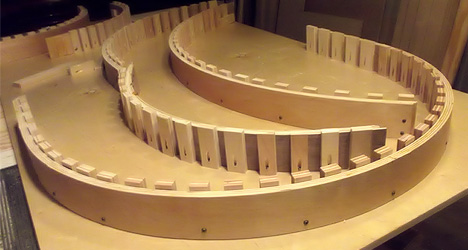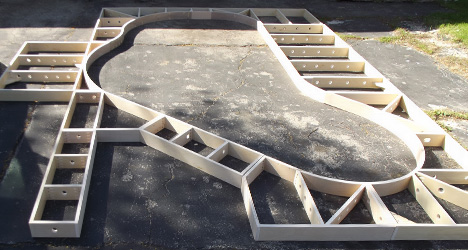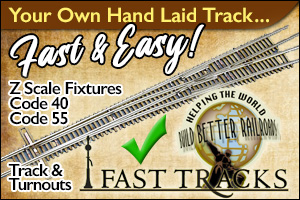OnDrew Hartigan | Model Railroad Benchwork
 There are a couple of companies out there building commercial benchwork for model railroaders. What’s different about your company, Model Railroad Benchwork?
There are a couple of companies out there building commercial benchwork for model railroaders. What’s different about your company, Model Railroad Benchwork?
The difference between modelrailroadbenchwork.com and other commercial benchwork companies is my ability to adapt to your needs. My goal really is to help the community grow. I do this by providing both a modular benchwork line as well as building custom benchwork. I build both the modular and custom benchwork to order, which means if you need a module 47 inches long instead of 48, I can do that at no additional cost. Another major difference is my exclusive use of cabinet grade birch plywood in all of my products.
Many people build their own benchwork from softwoods, such as pine, bought at their local home improvement center. Could you tell us the advantages of plywood over these soft woods?
Plywood is a wonderful product to work with and is very stable. Additionally, plywood allows a user to build complicated three-dimensional modules, which are very stable while still being relatively lightweight. Most modelers do not realize dimensional lumber, pine, for example, changes dimensions depending on the relative humidity of the location it’s placed. A pine 1×4 will change length as much as 1/4 inch depending on humidity and pine is also prone to twisting. As we all know, twisting is great for roller coasters, not model railroads.
Tell us a bit about yourself and why you decided to begin your company, Model Railroad Benchwork?
Having grown up next to the Chicago northwestern mainline, it was only natural that I become a model railroader. Over the years, I have experienced modeling in many scales and I even co-founded a train club back in 2001. It was during that time that I built my first piece of real benchwork. Over the next few years, I became a finish carpenter and home remodeler. In early 2010 I finally realized that I could combine two things I really enjoy, help the model railroading community grow, and start my own business.
I see on your site you also offer curved bench sections. How is this done?
Constructing curved benchwork is a multi-step process. Basically, what I do is build a jig on a sheet of plywood then glue laminate 4 layers of Luan plywood around the jig using a lot of clamps to hold it place. In short, a labor-intensive product takes 2 days to finish properly.

www.modelrailroadbenchwork.com
You mentioned cabinet grade plywood as well as an upgrade option of Baltic birch. What’s the difference between the two?
Cabinet grade birch plywood (CBP) is a great product but it is not perfect. CBP does have some voids and will develop a bow if not secured to something or built into a box like my benchwork. Baltic birch on the other hand is void free and is the strongest straightest plywood available, which allows me to use it in narrower strips, but it does have the drawback of being heavy and twice as expensive.
We’re seeing more Z scale users adopt the Z-Bend Track module standards. Can you build benchwork exactly to these Z scale standard?
Absolutely. In fact, I can build to any club or organizations standards provided I have a drawing or dimensions. Additionally, I am currently developing a Z-bend / N-Trak module kit. This kit will include the table as well as the legs for $89, allowing you to add a module to your club affordably, quickly, and without the woodwork.
If someone is building a small home layout, not a full Z scale module, is there still a benefit to using your benchwork?
Yes. In addition to not having to own, store or know how to use woodworking tools there is also the potential to save money verses purchasing plywood and then paying to have it ripped into useable pieces. Accuracy is another thing to keep in mind. When you order a modelrailroadbenchwork.com module you can rest assured that what you ordered is what you will receive. All of this is especially true when with small projects such as Ztrains.com’s 12″x48″ Waterfront Project.
How difficult is it for a beginner to assemble one of your basic rectangular benchwork shape?
Quite frankly, it’s pretty easy. I’ll admit it takes a little practice to become efficient at assembling my modules but even first time users have found the system easy to understand and assemble. To ensure you get some practice before you start assembling modules make sure you pick up a starter kit which comes with extra screws and 2 practice blocks.

www.modelrailroadbenchwork.com
Do you recommend sealing the benchwork once assembled and if so, what kind of sealant is recommended?
Sealing your benchwork ensures it will stay stable for a very long time. With plywood however it is not as vitally important because plywood is very stable when compared to dimensional lumber. If you are putting your benchwork in a humid area such as a basement, I recommend using polyurethane applied with a sponge and wiped off or oil based white paint. I recommend white because it makes under table wires and other items more visible.
Since we’re building in Z scale here, do you think your benchwork might be considered over engineering for Z? How does the weight of your plywood benchwork compare to soft wood benchwork?
Yes, I consider my benchwork over engineered but that’s not a bad thing for Z scale trains. With Z scale in particular it is vitally important to have a very rigid and stable base, and my benchwork provides both. As for weight, you will be surprised to know my benchwork is typically lighter than a similar pine 1×4 frame.
In conclusion, what would you say are the most compelling reasons for using your benchwork?
- Convenience: While I’m building your benchwork you can build structures, purchase track, and plan your layout.
- Cost / time savings: You don’t need to purchase materials or expensive tools or spend time designing / building your benchwork.
- Accuracy: You get what you need built accurately to your dimensions.
- Easy and little to no cost customizations of the modular line: Unless it’s complicated I do not charge extra for modifications to my modular products.
- Material choices otherwise not available or affordable, eg: Baltic birch
Category: Raildig Guest















